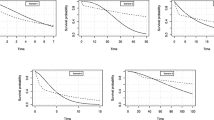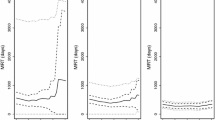Abstract
Although mean residual lifetime is often of interest in biomedical studies, restricted mean residual lifetime must be considered in order to accommodate censoring. Differences in the restricted mean residual lifetime can be used as an appropriate quantity for comparing different treatment groups with respect to their survival times. In observational studies where the factor of interest is not randomized, covariate adjustment is needed to take into account imbalances in confounding factors. In this article, we develop an estimator for the average causal treatment difference using the restricted mean residual lifetime as target parameter. We account for confounding factors using the Aalen additive hazards model. Large sample property of the proposed estimator is established and simulation studies are conducted in order to assess small sample performance of the resulting estimator. The method is also applied to an observational data set of patients after an acute myocardial infarction event.

Similar content being viewed by others
References
Aalen OO (1980) A model for non-parametric regression analysis of counting processes. In: Klonecki W, Kozek A, Rosinski J (eds) Mathematical Statistics and Probability Theory, Lecture Notes in Statistics. Springer, New York, pp 1–25
Andersen PK, Borgan Ø, Gill RD, Keiding N (1993) Statistical models based on counting processes. Springer, New York
Chen PY, Tsiatis AA (2001) Causal inference on the difference of the restricted mean lifetime between two groups. Biometrics 57(4):1030–1038
Hubbard AE, van der Laan MJ, Robins JM (2000) Nonparametric locally efficient estimation of the treatment specific survival distribution with right censored data and covariates in observational studies. In: Halloran ME, Berry D (eds) Statistical models in epidemiology, the environment and clinical trials, IMA volumes in mathematics and its applications, vol 116. Springer, New York, pp 135–177
Karrison T (1987) Restricted mean life with adjustment for covariates. J Am Stat Assoc 82(400):1169–1176
Martinussen T, Scheike TH (2006) Dynamic regression models for survival data. Springer, New York
Martinussen T, Scheike TH, Skovgaard IM (2002) Efficient estimation of fixed and time-varying covariate effects in multiplicative intensity models. Scand J Stat 29(1):57–74
Murphy SA, Sen PK (1991) Time-dependent coefficients in a Cox-type regression model. Stoch Process Appl 39(1):153–180
Pearl J (1995) Causal diagrams for empirical research. Biometrika 82(4):669–688
Pearl J (2000) Causality: models, reasoning and inference, vol 29. Cambridge University Press, Cambridge
Robins JM (1986) A new approach to causal inference in mortality studies with a sustained exposure periods—application to control of the healthy worker survivor effect. Math Model 7(9):1393–1512
Rubin DB (1974) Estimating causal effects of treatments in randomized and nonrandomized studies. J Educ Psychol 66(5):688–701
Rubin DB (1978) Bayesian inference for causal effects: the role of randomization. Ann Stat 6(1):34–58
Stare J, Henderson R, Pohar M (2005) An individual measure of relative survival. J R Stat Soc Ser C 54(1):115–126
Tian L, Zucker DM, Wei L (2005) On the Cox model with time-varying regression coefficients. J Am Stat Assoc 100(469):172–183
Zhang M, Schaubel DE (2011) Estimating differences in restricted mean lifetime using observational data subject to dependent censoring. Biometrics 67(3):740–749
Zucker DM (1998) Restricted mean life with covariates: modification and extension of a useful survival analysis method. J Am Stat Assoc 93(442):702–709
Zucker DM, Karr AF (1990) Non-parametric survival analysis with time-dependent covariate effects: a penalized partial likelihood approach. Ann Stat 18(1):329–353
Acknowledgments
The authors would like to thank an associate editor and two anonymous reviewers for their constructive comments that greatly improved the paper. This research was supported by the Ministry of Science, Research and Technology of Iran.
Author information
Authors and Affiliations
Corresponding author
Appendices
Appendix 1: Weak convergence of \(n^{1/2}\{\hat{S}_a(t)-S_a(t)\}\)
According to Martinussen and Scheike (2006, p. 118), \(n^{1/2}\{\hat{B}(t)-B(t)\}\) can be written as
where
is the martingale process. When n is large, representation (5) is equivalent to a sum of independent and identically distributed zero-mean martingales
where
and w(t) is the limit in probability of \(\{n^{-1}Z^T(t)Z(t)\}^{-1}\).
We now turn to the proof for the weak convergence of \(n^{1/2}\{\hat{S}_a(t)-S_a(t)\}\). Define
so that \(S_a(t)=S(t \mid \hat{A}=a)=S_{a1}(t) \; S_{a2}(t)\), and likewise, define
where \(\hat{S}_a(t)=\hat{S}_{a1}(t) \; \hat{S}_{a2}(t)\). Then it easily follows that
Taking the Taylor series expansion of \(\hat{S}_{a1}(t)\), together with the consistency of \(\hat{B}(t)\) yields that
where
In the latter display, \(\varepsilon _i^{B_0}(t)\) and \(\varepsilon _i^{B_A}(t)\) are defined as the influence function of \(n^{1/2}\{\hat{B}_0(t)-B_0(t)\}\) and \(n^{1/2}\{\hat{B}_A(t)-B_A(t)\}\), respectively, given in (6).
By a Taylor series expansion of \(\hat{S}_{a2}(t)\) along with the consistency of \(\hat{B}(t)\) and the uniform strong law of large numbers, it further follows that
where
with \(\mu (t)\) being the limit in probability of \(n^{-1}\sum _{i=1}^n\exp \{-X_i^TB_X(t)\}X_i^T\). In the latter display, \(\varepsilon _i^{B_{X}}(t)\) is defined as the influence function of \(n^{1/2}\{\hat{B}_X(t)-B_X(t)\}\), given in (6).
Therefore, combining the results from Eqs. (7), (8) and (9) follows that \(n^{1/2}\{\hat{S}_a(t)-S_a(t)\}\) can be decomposed as a sum of independent and identically distributed terms as
where
Appendix 2: Weak convergence of \(n^{1/2}\{\hat{\delta }(t)-\delta (t)\}\)
To find the influence function for \(n^{1/2}\{\hat{\delta }(t)-\delta (t)\}\), it follows that
It can also be written that, for \(a=0,1\),
is equal to
Using expression (10), asymptotic approximation for \(n^{1/2}\{\hat{\delta }(t)-\delta (t)\}\) can be displayed by
where \(\varepsilon _i^{\delta }(t)=\varepsilon _i^{\delta _1}(t) -\varepsilon _i^{\delta _0}(t)\) with
Rights and permissions
About this article
Cite this article
Mansourvar, Z., Martinussen, T. Estimation of average causal effect using the restricted mean residual lifetime as effect measure. Lifetime Data Anal 23, 426–438 (2017). https://doi.org/10.1007/s10985-016-9366-z
Received:
Accepted:
Published:
Issue Date:
DOI: https://doi.org/10.1007/s10985-016-9366-z




